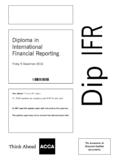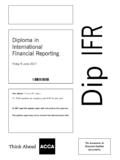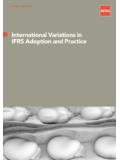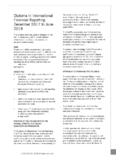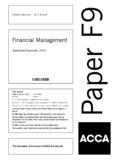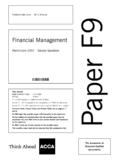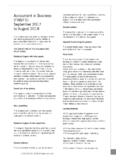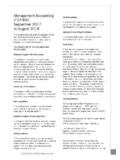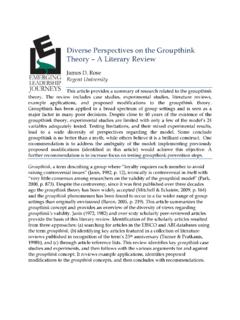Transcription of Corporation tax and groups – group relief - ACCA …
1 RELEVANT TO ACCA QUALIFICATION PAPER P6 (UK) AND. PERFORMANCE OBJECTIVES 19 AND 20. Corporation tax and groups group relief This is the Finance Act 2011 version of this article. It is relevant for candidates sitting the Paper P6 (UK) exam in 2012. Candidates sitting Paper P6 (UK) in 2013 should refer to the Finance Act 2012 version of this article, to be published on the ACCA website in 2013. This is the first of two articles on Corporation tax and groups . The second covers groups and chargeable gains. groups of companies are an important aspect of Corporation tax within paper P6 (UK).
2 Having studied the basics of this area at Paper F6, you are now expected to progress to more advanced aspects. However, the basic rules continue to be of vital importance as they are the foundation on which the additional rules rest. You must have a sound knowledge of the many rules within this subject if you are to be able to handle an exam question involving groups . This is not an introductory article; it is relevant to students coming to the end of their studies and finalising their preparations to sit the exam. It begins by briefly summarising the rules relating to both group relief groups and capital gains groups .
3 It then goes on to consider a number of group relief tax planning issues that could be introduced in an exam question. It does not include comprehensive explanations of the rules but assumes a reasonable knowledge. This article is intended to be read proactively ie statements made should be confirmed as true by reference to the reader's understanding of the rules, or to a relevant study text. This approach will enable future situations to be analysed from first principles rather than by reference to a rigid set of memorised planning points. The tax rates and limits for financial year 2011, ending on 31 March 2012, are used throughout this article.
4 THE BASIC RULES. The structure of the H Ltd group of companies is set out in Figure 1. It should be assumed, at least to begin with, that all of the companies are resident in the UK. The minority shareholders in the group companies are companies with no relationship with H Ltd. You should be able to review the group structure and confidently identify the members of any group relief groups and capital gains groups . Try to do this before you read the information in Table 1. FIGURE 1: THE STRUCTURE OF THE H LTD group OF COMPANIES. H Ltd 80% 100% 60%. 64%.
5 A Ltd C Ltd D Ltd 80%. B Ltd 2012 ACCA. 2 Corporation TAX AND groups MARCH 2012. TABLE 1: group relief AND CAPITAL GAINS groups RE FIGURE 1. group relief group Capital gains group The groups H Ltd, A Ltd and C Ltd form a H Ltd, A Ltd, B Ltd and C Ltd group . form a single group . A Ltd and B Ltd form a separate group . Rationale B Ltd is not in a group with B Ltd is in a group with H Ltd H Ltd because the effective because: interest of H Ltd in B Ltd is H Ltd has a direct interest in less than 75%. A Ltd of at least 75% and A Ltd has a direct interest in B Ltd of at least 75%, and the effective interest of H Ltd in B Ltd is greater than 50%.
6 Once a group relief group exists, the following applies: Any company in the group can surrender current period trading losses, non-trading deficits on loan relationships, excess property business losses, excess management expenses, and excess gift aid donations to any other company in the group . The maximum surrender to a group company is that company's taxable total profits. For this purpose, a company's taxable total profits are reduced by its own trading losses for the current period regardless of whether or not such a loss claim is made. Before you study the further issues set out below, consider the tax implications of making the following mutually exclusive changes to the H Ltd group structure.
7 1. B Ltd owns 90% of W Ltd. 2. Rather than H Ltd owning A Ltd, C Ltd and D Ltd, the owner is Mr H, a UK resident individual. The implications are summarised at the end of this article. TAX PLANNING ISSUES RELATING TO group relief . The remainder of this article examines the tax planning issues relating to group relief groups . Throughout this review of tax planning issues, the term losses' will be used to represent any/all tax attributes that can be surrendered via group relief . Companies resident overseas Companies resident overseas are included within a group relief group .
8 However, losses can only be surrendered between companies that are resident in the UK or are resident overseas but have a permanent establishment in the UK. If the H Ltd group were owned by H Inc, a company resident and trading outside the UK and the European Union, rather than H Ltd, the members of the group relief groups would not change. However, losses could only be surrendered between A Ltd and C Ltd and between A Ltd and B Ltd. 2012 ACCA. 3 Corporation TAX AND groups MARCH 2012. Planning the distribution of losses to members of the group The value of a company's losses depends on how they are used.
9 This value is maximised by offsetting the losses against those profits that would otherwise be taxed at the highest rate of tax. A company will pay tax at the main rate where its augmented profits (taxable total profits plus its franked investment) exceed the upper limit, at the lower small profits rate where they are less than the lower limit and at a rate in excess of the main rate on those profits between the lower and upper limits. Accordingly, the aim is to offset the losses against: profits between the limits, then profits in excess of the upper limit, then profits below the lower limit.
10 Most, if not all, students are aware of this strategy but many misinterpret what it means and think that it is disadvantageous for a company to have profits between the limits. In fact, the opposite is true. Companies with profits between the limits pay a rate of tax in excess of the main rate only on the amount of profits between the limits and not on all of their profits. The overall effective rate of tax paid by such companies must, of course, be less than the main rate as the Corporation tax liability is computed by charging tax at the main rate and then deducting marginal relief .

